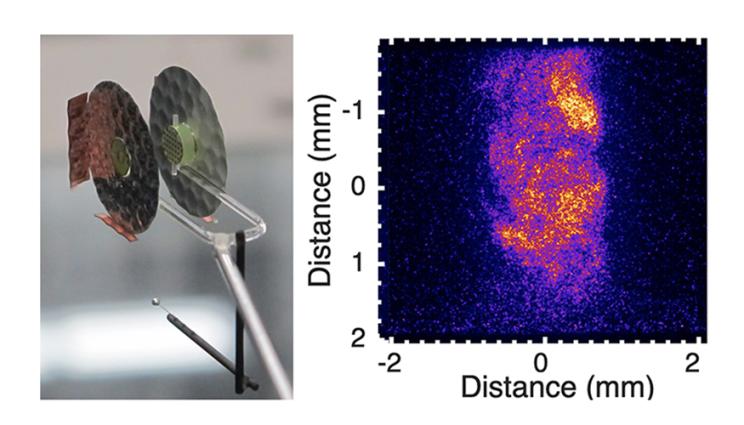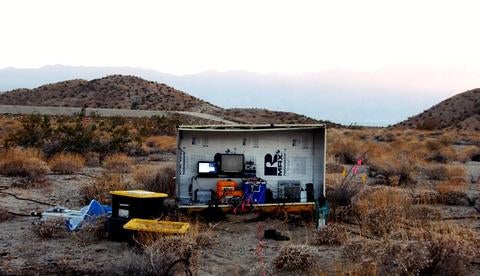2022-03-09 ローレンス・リバモア国立研究所(LLNL)
オックスフォード大学物理学科、ロチェスター大学、シカゴ大学の科学者が率いる国際研究チームは、ローレンス・リバモア国立研究所(LLNL)の国立点火施設(NIF)を利用して、宇宙最大の構造である銀河団における熱伝導の内部機構を解明しました。

左:ディスカバリーサイエンス計画でNIFに配備された乱流ダイナモ(TDyno)ターゲット。実験ターゲットは、2枚のフォイルと1組のグリッドからなり、円筒形のシールドで支えられている。各ターゲットは1円玉ほどの大きさ。写真右。レーザー発射後、約280億分の1秒後に撮影された、実験で発生した乱流プラズマのX線画像。高温のプラズマからは軟X線が放射され、乱流の特性を明らかにするとともに、熱輸送が強く抑制されていることを明らかにした電子温度の揺らぎを測定することができる。
Credit: NIF Operations Team.
<関連情報>
銀河団乱流プラズマの実験室レプリカにおける熱伝導の強い抑制
Strong suppression of heat conduction in a laboratory replica of galaxy-cluster turbulent plasmas
JENA MEINECKE 、PETROS TZEFERACOS 、JAMES S. ROSS 、ARCHIE F. A. BOTT 、COTT FEISTER 、HYE-SOOK PARK 、ANTHONY R. BELLROGER BLANDFORD 、RICHARD L. BERGERROBERT BINGHAM 、ALEXIS CASNER 、LAURA E. CHENJOHN FOSTER 、DUSTIN H. FROULA 、CLEMENT GOYON 、DANIEL KALANTARMICHEL KOENIGBRANDON LAHMANN 、CHIKANG LI 、YINGCHAO LUCHARLOTTE A. J. PALMER 、RICHARD D. PETRASSOHANNAH POOLEBRUCE REMINGTON 、BRIAN REVILLE 、ADAM REYES 、ALEXANDRA RIGBYDONGSU RYU 、GEORGE SWADLING 、ALEX ZYLSTRA 、FRANCESCO MINIATISUBIR SARKAR 、XALEXANDER A. SCHEKOCHIHIN 、DONALD Q. LAMBAND GIANLUCA GREGORI
SCIENCE ADVANCES • 9 Mar 2022 • Vol 8, Issue 10 • DOI: 10.1126/sciadv.abj6799
Abstract
In conventional gases and plasmas, it is known that heat fluxes are proportional to temperature gradients, with collisions between particles mediating energy flow from hotter to colder regions and the coefficient of thermal conduction given by Spitzer’s theory. However, this theory breaks down in magnetized, turbulent, weakly collisional plasmas, although modifications are difficult to predict from first principles due to the complex, multiscale nature of the problem. Understanding heat transport is important in astrophysical plasmas such as those in galaxy clusters, where observed temperature profiles are explicable only in the presence of a strong suppression of heat conduction compared to Spitzer’s theory. To address this problem, we have created a replica of such a system in a laser laboratory experiment. Our data show a reduction of heat transport by two orders of magnitude or more, leading to large temperature variations on small spatial scales (as is seen in cluster plasmas).

図1. 2枚のポリスチレン(CH)円盤を8mm離し、スポット径1mmの96個の周波数3倍高調波(波長351nm)レーザーでアブレーションを行った実験構成。
FIG. 1. Experimental configuration.
Two polystyrene (CH) disks are separated by 8 mm and ablated with 96 frequency-tripled (351 nm wavelength) laser beams with a 1 mm spot diameter. The total laser illumination onto each disk is 133 ± 10 kJ in a 15 ns square pulse length. Turbulence is generated with plastic grid obstacles (300-μm aperture, 300-μm wires) located 2 mm away from each disk by disturbing both collimated flows before interpenetration and mixing. A gated x-ray detector (GXD) observes the chaotic mixing of the flows (shown here at 23 ns after the beginning of the laser drive), while proton radiography characterizes the self-generated magnetic fields. A 860-μm-diameter capsule, filled with 6 atm of D2 gas and 12 atm of 3He, is located 18 mm from the midpoint of the two disks and ablated with 60 frequency-tripled laser beams with a 200 μm spot that deliver 43 ± 5 kJ in a 900 ps square pulse length. The implosion produces 14.7-MeV monoenergetic protons that penetrate the interaction region and are collected by a CR-39 nuclear track detector. An optical Thomson scattering (OTS) probe of frequency-tripled light was focused to the midpoint between both disks, consisting of four beams, totaling 12.8 kJ in a 8 ns square pulse, to measure average electron density. In some shots, the OTS probe was swapped for a full-aperture backscatter system that measured the reflected light from four frequency-tripled lasers focused on the interaction region with 5.7 kJ in a 12.6 ns picket pulse and a 150 μm spot, to measure the turbulent velocity in the plasma.





